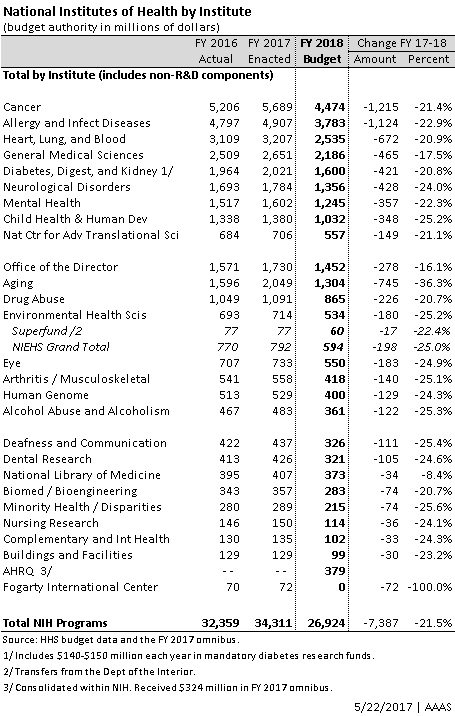The president's budget request – essentially, a wish list to Congress – is typically described by journalists and political pundits as "dead on arrival" (DOA) regardless of who is in charge of what branch of government. Congress takes their constitutional "power of the purse" very seriously, and while lawmakers do take the president's request into consideration, they take pride in making their own funding decisions that are more often than not at odds with the wishes of the president.
What differentiates President Trump's fiscal year 2018 budget request from budget requests of yore is the visceral and immediate opposition it generated from both Republicans and Democrats alike. (Is it possible to be deader than DOA?) Indeed, in this divided political climate it takes something truly extraordinary to bring Democrats and Republicans together. Fiscal hawks objected to the budget holding harmless Medicare and Social Security and using "fuzzy math" to produce an overly optimistic economic outlook. Defense hawks complained the proposed increase for the Pentagon was insufficient. Progressives decried the cuts to Medicaid and other safety net programs that support America's most vulnerable. And appropriators from both parties (those who control the government's purse strings) bluntly called the draconian cuts for domestic programs under their charge – from education to house, diplomacy to natural resources, housing to public health and beyond – "unrealistic" and "untenable."
The cuts to science generally, and the proposed cut of more than $7 billion to the National Institutes of Health (NIH), particularly, elicited an intense backlash on both sides of the aisle. Lawmakers' unified opposition is not surprising considering that not even one month before the president's budget release President Trump signed into law a bipartisan spending bill for fiscal 2017 that included a $2 billion increase for the NIH, following upon a $2 billion increase in fiscal 2016. A more than 20 percent cut to NIH in fiscal 2018 as proposed by the president would have devastating effects across all institutes and centers (see table below for proposed cuts by institute and center). We might expect that this cut would likely have a disproportionate effect on health services research and social science as NIH would be forced to triage support to its core mission of "basic science."

In defense of the budget request, Office of Management and Budget (OMB) Director Mick Mulvaney noted that one of the administration's primary goals was to root out duplicative programs. It did not come as a surprise then to see the proposed termination of the Agency for Healthcare Research and Quality (AHRQ). For the last five years, AcademyHealth has successfully led the charge against misperceptions among some House Republicans that AHRQ and NIH are duplicative. What was surprising is the proposed creation of a new NIH "Institute for Research on Safety and Quality" (NIRSQ) to carry on much of AHRQ's existing portfolio, albeit with a budget of almost 18.5 percent less than AHRQ's current budget. Indeed, the accompanying budget documents note:
Consolidating AHRQ into NIH will reduce duplication and improve the effectiveness of existing health services research. The Budget proposes that NIH will conduct a review of health services research across NIH, identify gaps, and propose a more coordinated strategy for ensuring that the highest priority health services research is conducted and then made available to improve the quality of health care services.
The new NIRSQ would increase funding for the Medical Expenditure Panel Survey (MEPS), maintain some of AHRQ's current programs, such as investigator-initiated research and patient safety, cut funding for contracted research, and terminate others, such as the health information technology portfolio. As we noted in our official statement, the budget request is an "unacceptable assault on health research and a threat to the important health services research," as the proposed funding levels are "grossly insufficient to respond to the complex challenges facing our health system." Nevertheless, the proposed creation of a new NIH institute in a budget where nearly every federal program sees cuts and several programs are terminated outright is a thin, silver lining that the administration sees value in this work. It may not seem like it, but it could certainly be a lot worse.
It’s important to note that nearly all of the president’s budget proposals, including the proposal to terminate AHRQ and create a new NIH institute for health services research, will require congressional action and are not likely to become a political reality (more on that in a future blog!). There are some concerning proposals, however, that could be done administratively and would send shockwaves through the research community. Among them is the proposal to limit to 10 percent the NIH’s support of “F&A costs” for facilities and administration, otherwise known as “indirect costs.” The NIH allocated $6.4 billion for such costs last year, or about 38 percent of its extramural budget. Capping such costs at 10 percent would generate approximately $4.7 billion in savings.
The idea of capping indirect costs is not a new idea, but it is gaining new momentum among some appropriators who are looking for savings wherever possible under austere spending caps, and Secretary of Health and Human Services Tom Price is seriously considering moving forward with the proposal with or without Congress’ blessing. They point to the indirect rates of private sector and philanthropic grants, many of which are capped at 10 percent, if they support such costs at all. Our sister research societies are leading the charge against this proposal, and AcademyHealth is supporting their efforts.
DOA or not, the president’s budget is a wake up call for the research community. We must remain ever vigilant in our efforts to educate lawmakers and the public about the value of our work, and the dire consequences of continued research cuts of any level.
For a copy of the HHS Budget in Brief, click here.
For a copy of the budget justification for NIRSQ (the Institute formerly known as AHRQ), click here.